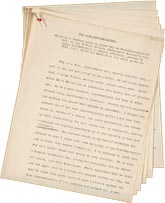Fry described Post-Impressionist art, in his Essay in Aesthetics first published in 1909, as 'the discovery of the visual language of the imagination'.
He suggests that the imagination is more important than the reality of 'mortal life'.
| I think that the artist might if he chose take a mystical activity and declare that the fullness and completeness of the imaginative life he leads
may correspond to an existence more real and more important than any that we know of in mortal life. |

Roger Fry, Vision and Design, 1920 |
Fry emphasised the importance of 'form', how a work looks, over 'content', what a work is about.
He thought that artists should use colour and arrangement of forms rather than the subject to express their ideas and feelings, and that works of art should not be judged
by how accurately they represent reality.
Even art that seemed innovative, such as paintings by the Impressionists or Whistler, were criticised by Fry because of their insistence on trying to capture a visual reality.
Fry championed the work of CÚzanne who experimented with colour and form at the expense of accurate perspective, and Van Gogh who wanted to paint emotional turmoil
even if this meant distorting what he saw. |

Sir Michael Sadler's Lecture Notes
for Roger Fry's 1911 Lecture
on Post-Impressionist Art
© Michael Sadler |
